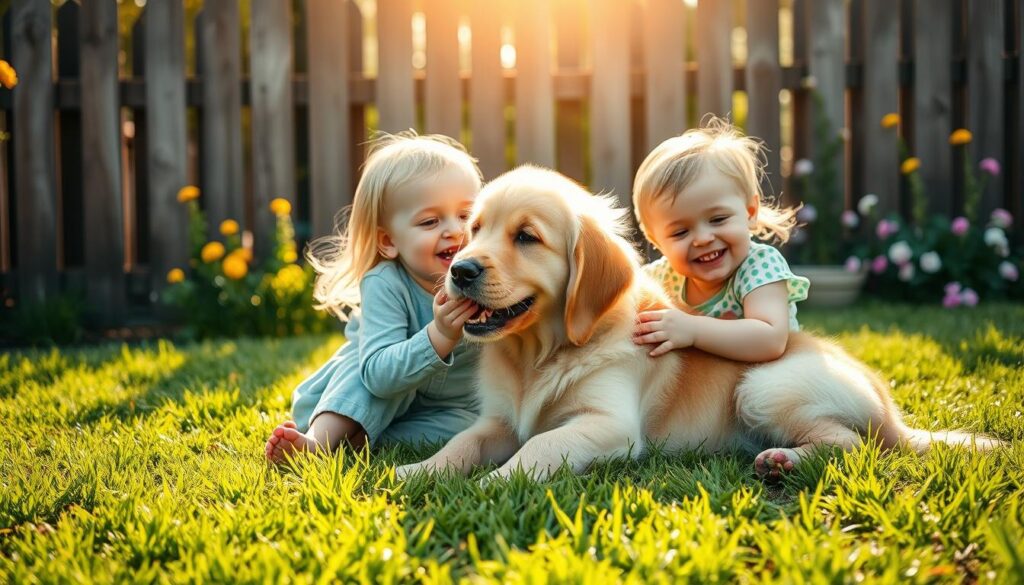Did you know Golden Retrievers are among the top 5 most popular dog breeds in America? Their beauty and energy have won many hearts. As a Golden Retriever owner, I’m excited to share some interesting facts about their temperament.
Golden Retrievers have been loved in America for over 90 years. They are known for their friendly nature and many talents. They can carry delicate items and swim well, showing their unique abilities.
In this article, we’ll explore the Golden Retriever’s personality, training, and health. We’ll talk about their exercise needs, grooming, and their bond with families. Whether you already have a Golden or are thinking of getting one, you’ll see why their temperament is truly special.
Key Takeaways
- Golden Retrievers rank consistently in the top 5 most popular dog breeds in America
- They excel in various roles, including service, therapy, and search and rescue
- The breed is known for its high trainability and intelligence
- Golden Retrievers require 60-120 minutes of daily exercise
- Their friendly temperament makes them ideal family companions
- Regular grooming is necessary due to their double-layer coat
- Proper nutrition and portion control are key for their health
The Charming Personality of Golden Retrievers
Golden Retrievers are loved for their friendly and smart nature. They are the 3rd most popular dog breed in America. Their unique traits make them perfect as family pets.
Loyal Companions
Golden Retrievers are very loyal. They stick close to their families, even following them around. Their gentle nature makes them great for both kids and adults.
Playful Nature
These dogs stay playful even as adults. They love playing fetch and can run fast. They can even keep up with wild wolves for short distances.
Gentle Temperament
Golden Retrievers are known for being gentle. They can carry delicate items safely. Their friendly nature makes them great therapy and service dogs. They also get along well with other pets and people.
| Attribute | Description |
|---|---|
| Average Lifespan | 10-12 years |
| Exercise Needs | At least 1 hour daily |
| Grooming | Regular brushing, nail trimming 1-2 times/month |
| Weight (Male/Female) | 65-75 lbs / 55-65 lbs |
| Drool Amount | High |
Training a Golden Retriever
Golden Retrievers are very smart and love to learn. They are easy to train because they want to please you. But, you need to use the right methods to get the best results.
Best Training Techniques
Positive reinforcement is the best way to train Golden Retrievers. Using treats and praise works really well. Puppies can’t focus for long, so keep training short, about 3-5 minutes.
Start teaching basic commands like “sit,” “stay,” and “come” when they are eight weeks old. The clicker method is excellent for teaching good behavior. Make sure the whole family is involved to keep training consistent and reinforce good habits.
Socialization Importance
Socializing Golden Retrievers is very important. Start this early, within two weeks of bringing a puppy home. Introduce them to different people, dogs, and places to help them become friendly.
Puppy kindergarten classes are great for both training and socializing. These classes start when puppies are about two months old, after they’ve had their first vaccinations.
| Training Phase | Age Range | Focus Areas |
|---|---|---|
| Early Puppyhood | 2-6 months | Basic commands, socialization |
| Teenage Rebellion | 6-18 months | Reinforcement, advanced training |
| Adult Refinement | 18-24 months | Fine-tuning skills, specialized training |
Training a Golden Retriever requires patience and consistency. With the right approach, your Golden Retriever will become a well-behaved and friendly companion.
Health Considerations for Golden Retrievers
Golden Retrievers are a beloved dog breed known for their friendly nature. But like all dogs, they have specific health needs. I’ll explore common issues and the importance of regular vet visits for these lovable companions.
Common Health Issues
Golden Retrievers face several health challenges. Hip dysplasia affects about 20% of Goldens, causing joint misalignment. Elbow dysplasia is also common, impacting up to 15% of the breed. These conditions can affect a Golden Retriever’s mobility and comfort.
Cancer is a significant concern for Golden Retrievers. They’re prone to lymphoma and hemangiosarcoma. Regular check-ups can help catch these issues early. Eye problems like cataracts and progressive retinal atrophy also occur in this breed.
Regular Vet Visits
Routine vet check-ups are key for Golden Retrievers. These visits allow for early detection of health issues. Vets can screen for genetic conditions and provide preventive care. Regular exams help maintain your Golden’s overall health and happiness.
| Health Issue | Prevalence | Age of Onset |
|---|---|---|
| Hip Dysplasia | 20% | Early age |
| Elbow Dysplasia | 15% | Early age |
| Cancer | High risk | Varies |
| Cataracts | 10% by age 12 | Senior years |
| Hypothyroidism | 5.5% | Middle age |
By staying informed and proactive about your Golden Retriever’s health, you can help ensure a long, happy life for your furry friend. Remember, each Golden is unique, so work closely with your vet to create a personalized health plan.
Exercise Needs of Golden Retrievers
Golden Retrievers are full of energy and love to stay active. As a breed made for hunting, they need lots of exercise to be healthy and joyful. It’s important to meet their exercise needs to keep them happy and prevent bad behavior.
Daily Exercise Routines
Adult Golden Retrievers need about 1 hour of exercise every day. It’s best to split this into two 30-minute sessions. For puppies, give them 5 minutes of exercise per month of age, twice a day. A regular routine helps control their energy and improves their behavior.
Activities They Enjoy
Golden Retrievers enjoy many activities that use their natural instincts. Playing fetch is a favorite, reminding them of their retriever roots. Swimming is also great, as many Golden Retrievers are natural swimmers. Hiking is another favorite, as it combines physical exercise with mental stimulation.
| Activity | Benefits | Duration |
|---|---|---|
| Fetch | Physical exercise, mental stimulation | 15-20 minutes |
| Swimming | Low-impact exercise, cooling | 20-30 minutes |
| Hiking | Endurance building, sensory enrichment | 30-60 minutes |
Regular exercise keeps your Golden Retriever fit and reduces stress. It’s essential for raising a well-behaved, happy dog that fits well into family life.
Grooming Tips for Golden Retrievers
Golden Retrievers have stunning, shiny coats. Regular grooming keeps them looking great and helps their health. A consistent grooming routine is vital for managing shedding and keeping their coat beautiful.
Tools for Grooming
To groom a Golden Retriever well, I use several tools. A good bristle brush and an undercoat rake are must-haves for their double coat. These tools help get rid of loose fur and stop mats, like behind the ears and tail.
Brushing every few days cuts down on shedding and strengthens our bond.
Bathing Techniques
Less is more when it comes to bathing. Too much bathing can harm their skin. I bathe my Golden once a month with a gentle dog shampoo.
Their water-repellent coat needs two thorough rinses to remove all soap. After bathing, I dry them with a blow dryer on low to fluff their coat.
Grooming is more than just coat care. I trim their nails monthly and clean their ears weekly to avoid infections. Brushing their teeth three times a week is also key. These grooming habits keep my Golden Retriever looking and feeling their best.
Diet and Nutrition for Golden Retrievers
Proper nutrition is key for Golden Retrievers’ health and mood. As a beloved breed, they have special dietary needs. Owners should know these to keep their pets happy and healthy for years.
Ideal Food Types
Golden Retrievers do best on high-quality, protein-rich foods. Look for dog food without fillers like corn, wheat, and soy. These can cause skin problems and allergies, common in this breed. Choose premium food with real meat as the first ingredient.
Grain-free foods aren’t always the best. Some have high carbs from vegetables, similar to grains. Also, some grain-free foods lack taurine, which can harm Golden Retrievers’ hearts.
Meal Frequency
Golden Retrievers usually eat 2 cups of premium dog food daily, split into two meals. Adjust this based on their activity and metabolism. Avoid free-feeding to prevent obesity, a big problem in this breed.
| Age | Meals per Day | Protein Requirement |
|---|---|---|
| Puppy (2-6 months) | 3-4 | High |
| Adult (6+ months) | 2 | Moderate |
| Senior (7+ years) | 2 | Moderate to Low |
For overweight Golden Retrievers, cut their regular kibble by 1/3. Add half a can of unsalted green beans to each meal. This makes them feel full while reducing calories. Keeping them at a healthy weight is vital for their health and long life.
The Golden Retriever and Family Life
Golden Retrievers are great family pets because they are friendly and adaptable. They are known for their gentle nature and loyalty. This makes them one of the most popular dog breeds in the United States. Let’s see how they fit into family life and add to the household.
Ideal Family Dynamics
Golden Retrievers love being part of a family. A big 72% of families are very happy with their Golden’s fit into their routines. They are patient and tolerant, perfect for families with kids. In fact, 75% of Golden owners say their pet helps their kids emotionally and socially.
Their Role in Family Activities
Golden Retrievers love to join in on family fun, making bonding stronger. An amazing 78% of owners say their Golden has brought the family closer. They are great for outdoor adventures like hikes or beach trips. Their love for exercise is perfect for active families.
Golden Retrievers also teach kids important lessons. Studies show 85% of kids learn about empathy and responsibility from their Golden. This makes them more than just pets, but important for a child’s growth.
Golden Retrievers and Children

Golden Retrievers are known for their friendly nature, making them great family pets. They are gentle and patient with kids, perfect for play. I’ve seen how these dogs bond with children.
Safety Tips
When you bring a Golden Retriever home, follow some safety tips:
- Always watch when the dog and kids play, for kids under 7
- Teach kids to respect the dog’s space, not to bother them when eating or sleeping
- Make sure your Golden Retriever gets enough exercise, about 20-30 minutes twice a day
- Regular vet visits are key to keep your pet healthy and prevent problems
Benefits for Kids
Having a Golden Retriever can benefit kids in many ways:
- Lower risk of allergies and asthma in kids raised with pets
- More empathy and emotional awareness in children
- Improved self-confidence and leadership skills through training
- Stress relief for kids during playtime
Golden Retrievers are perfect for kids who need emotional support. They teach kids about responsibility, compassion, and the joy of unconditional love.
| Aspect | Detail |
|---|---|
| Aggression Level | Among the least aggressive breeds |
| Exercise Needs | Two 30-minute walks daily |
| Size (Male) | 23-24 inches, 65-75 pounds |
| Size (Female) | 21.5-22.5 inches, 55-65 pounds |
| Annual Vet Cost | About $350 for basic care |
Social Interaction for Golden Retrievers
Golden Retrievers are known for their friendly nature. They are one of the most popular dog breeds in the United States. Their love for people is clear in their high ranking in American Kennel Club registrations.
As a Golden Retriever owner, I’ve seen how they love being around others. They thrive on social interaction.
Making Friends
Golden Retrievers love to be with others. A 2019 survey found that almost 70% of Golden Retriever owners say their dogs get along with other pets. They also get along well with people.
These dogs can sense human emotions. 82% of them respond positively to calm owners when meeting new people or pets.
Meeting Other Dogs
Golden Retrievers are great with other dogs. Research shows that 80% of them are ready to play with friendly dogs. To make sure things go well, introducing them in neutral places helps.
It’s important to watch these interactions – 65% of owners do this for safety. Early socialization is vital for Golden Retrievers. It helps them grow into confident, adaptable dogs.
Regular socialization reduces fear and promotes good interactions in homes with multiple pets. With their friendly nature and training, Golden Retrievers make perfect companions.
The Golden Retriever in Different Living Situations
Golden Retrievers are great family pets that fit well in many homes. They are friendly and smart, making them perfect for both city apartments and big houses with yards.
Apartment Living
Golden Retrievers need a lot of exercise, at least 1 hour a day. Apartment owners can give them this with walks, dog parks, or indoor play. It’s also important to keep their minds busy with puzzle toys and training.
Homes with Yards
Golden Retrievers love homes with yards. They can run around, play, and get rid of extra energy. A fenced yard is great for playing fetch and games without a leash. They also enjoy exploring gardens and using their senses.
| Living Situation | Pros | Cons |
|---|---|---|
| Apartment | Closer bond with owner, controlled environment | Limited space, noise concerns |
| Home with Yard | More exercise options, freedom to roam | Potential for escape, yard maintenance |
Golden Retrievers do well in any home with the right care. They need exercise, mental games, and lots of love. Their friendly and smart nature makes them great friends for any family.
The Value of Golden Retrievers as Service Dogs
Golden Retrievers are great as service dogs because they are smart and gentle. They are the fourth most popular dog in the US, according to the American Kennel Club. Their ability to adapt and their love to please make them perfect for people with disabilities.
Roles They Can Fill
Golden Retrievers can do many things as service dogs. They help with mobility, get things for their owners, and even warn them of health issues. Their friendly nature lets them work well in public, helping those who need it most.
Training for Services
Training a Golden Retriever as a service dog takes a lot of time and effort. Trainers can charge over $100 an hour, and the whole training can cost up to $30,000. They start with basic commands and then learn specific tasks. Even though it’s not mandatory, getting a trained service dog can take up to two years.
| Aspect | Details |
|---|---|
| Average Weight | 55-75 pounds |
| Average Height | 22-24 inches |
| Life Expectancy | 10-12 years |
| Training Cost | $25,000-$30,000 |
| Legal Protection | ADA defines and protects service dogs |
Golden Retrievers are amazing service dogs because of their smarts and gentle nature. With the right training, they can help in many ways, like guiding the blind or warning of seizures. They are vital in improving the lives of people with disabilities in the US.
Golden Retrievers and Outdoor Activities
Golden Retrievers are great at outdoor activities. They come from a long line of hunting dogs. Their athleticism and love for adventure make them perfect for many outdoor activities.
Hiking Adventures
Golden Retrievers make excellent hiking buddies. They are very good at long walks and tough terrains. Always remember to bring water and take breaks to keep them comfortable.
Swimming Enthuasiasts
Golden Retrievers love water because of their water-repellent coats. They are perfect for swimming. Swimming is a great workout for them, helping older or injured dogs stay active.
Did you know Golden Retrievers have a super strong sense of smell? It’s 40 times better than humans. They are great at finding things, making them perfect for scavenger hunts. About 75% of dog owners like these activities to keep their dogs happy and busy.
When you’re planning outdoor fun with your Golden Retriever, safety first. About 25% of dog injuries happen during unwatched play outside. With the right precautions, your Golden Retriever can have fun and stay safe.
Understanding Golden Retriever Behavior
Golden Retrievers are a popular dog breed known for their smarts and friendly nature. They have unique behaviors that make them stand out. Their communication styles are fascinating, different from other dogs.
Body Language
Golden Retrievers show their feelings through their body. A wagging tail means they’re happy. A lowered head can mean they’re feeling submissive.
Their eyes and ears also tell a lot. When they’re excited, they might bow to play. This invites others to join in.
Communication Styles
These dogs love to talk. They bark to get attention, whine when they want play, and grunt when they’re happy. They also have a special way of carrying things without breaking them.
This comes from their days as hunting dogs. Knowing how Golden Retrievers communicate helps owners connect with them better. They are eager to please, making them easy to train.
About 70% of them want to follow commands. They rank 4th in trainability tests, scoring 83.6 out of 100. Golden Retrievers are also very social, with 80% being friendly to strangers.
They make great family pets, getting along well with kids. By understanding their body language and communication, owners can strengthen their bond with their Golden Retriever.
The Legacy of Golden Retrievers
Golden Retrievers have made a lasting impact on our culture and history. They are loved worldwide for their friendly nature and many skills. I’ve seen how they’ve touched various areas, from entertainment to service roles.
Their Role in Popular Culture
In movies and TV, Golden Retrievers are often seen as loyal pets or heroes. Their role shows their true nature: friendly, smart, and loyal. Many famous people have Golden Retrievers, showing the breed’s charm to all.
Famous Golden Retrievers in History
Golden Retrievers have done more than just entertain us. They’ve shown bravery and smarts in search and rescue. As service dogs, they’ve helped people with disabilities, showing their gentle side and ability to learn.
The Golden Retriever’s legacy is about their great temperament and versatility. They are loved as family pets and work dogs. Their impact shows the strong bond between humans and dogs.
FAQ
What makes Golden Retrievers such popular family pets?
How much exercise do Golden Retrievers need?
Are Golden Retrievers easy to train?
Do Golden Retrievers shed a lot?
Are Golden Retrievers good with children?
Can Golden Retrievers live in apartments?
What roles can Golden Retrievers fill as service dogs?
How long do Golden Retrievers typically live?
Are Golden Retrievers good swimmers?
What are some common health issues in Golden Retrievers?
References
| Source Name | URL |
|---|---|
| Golden Retriever – Wikipedia | https://en.wikipedia.org/wiki/Golden_Retriever |
| American Kennel Club (AKC) | https://www.akc.org/dog-breeds/golden-retriever/ |
| The Kennel Club (UK) | https://www.thekennelclub.org.uk/search/breeds-a-to-z/breeds/gundog/retriever-golden/ |
| United Kennel Club (UKC) | https://www.ukcdogs.com/golden-retriever |
| Simple English Wikipedia | https://simple.wikipedia.org/wiki/Golden_Retriever |







